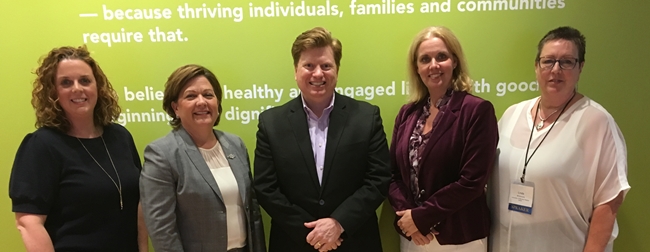
By Megan Headley

Four exceptional healthcare leaders took time to share their unique journeys to the top during the Mid-Atlantic Hospital, Outpatient Facilities and Medical Offices Building Summit held recently at Kaiser’s Center for Total Health in Washington, DC. Their paths included setbacks, sabbaticals and shifting priorities — and are reflective of only about 30 percent of healthcare leaders, according to data from the 2019 Oliver Wyman report on Women in Healthcare Leadership.
The Rise of Women in Healthcare Roles panel, co-sponsored by the Association of Medical Facility Professionals and Women in Healthcare, explored how these leaders, their organizations and the industry at large are encouraging diversity, and how far they’ve yet to go.
Comprising the panel:
- Kathy Gorman, Executive Vice President of Patient Care Services and Chief Operating Officer at Children’s National Health System
- Jill Johnson, FACHE, VP/Operations, Medstar Harbor Hospital
- Ashley Schmidt, VP/Business Development Director, HKS, and President of Women in Healthcare
- Linda Whitmore, Director of Project Development, University of Maryland Medical Center
The Formula to Move Forward
Schmidt, sees three areas in which organizations need to focus to drive greater gender equality in healthcare: professional development, culture and policy. Many healthcare systems have some form of leadership training, in some instances balanced with training specifically geared toward women. It’s culture, Schmidt says, that can be trickier to master.
“We can’t just say we need more ‘great top-down leaders,’ ” she points out. Instead, it’s important to have tools — such as policy — that help move the culture forward.
Perhaps the greatest argument for health systems to push these types of policies is that the evidence demonstrates that diversity boosts innovation, and healthcare today is in need of innovation.
Whitmore has seen this effect of diversity firsthand. She explained that she had the luxury of knowing her five male predecessors and the staff they had hired. As people tend to do, they had hired individuals who held similar credentials to themselves, which led to a fairly homogenous department of engineers. As Whitmore came in and prioritized diversity, new types of credentials held by her team led to new strengths within the department.
Of course, focusing on diversity can make it that much more disconcerting to see it so frequently overlooked. As Whitmore bluntly put it in describing her work in assembling contractor teams, “I’m continually shocked at finding myself across the table from a group of 50-year-old white men. I think to be that non-diverse takes work.”
A show of support
Of course, there are many reasons behind the lack of gender diversity in healthcare and other industries, from unconscious bias to childbearing to male-skewed networking activities. But many health systems are working to change that through diversity programs and leadership training aimed at a range of applicants.
However, the key isn’t aiming leadership development programs to women, these panelists suggested. Instead, the most effective strategy is to pair women with mentors who encourage them to speak up and follow their passions.
“Find a mentor you can connect with,” Gorman advised the audience. Given that female leaders are scarce in healthcare, the panelists encouraged young colleagues to look for anyone, male or female, who will push you to be your best self.
Mentorships play a central role in Children’s Hospital’s WatCH (Women at Children’s Hospitals) program. The program began as a series of lectures aimed at addressing the challenges women face in medicine and academia, and grew from there.
Mentorship is also at the heart of Women in Healthcare. Schmidt notes, “Personally, I’ve always had strong male mentors.” For Schmidt, that stands out particularly strong in the face of negativity she has faced from women in leadership roles.
Johnson refers to that negativity as “lobster syndrome.” It’s commonly observed that lobsters trying to move out of the tank are held down by other lobsters. The same scenario has become a familiar trope to many women in too many workplaces.
“As women rise, the target on our backs get bigger — and we’re targeted by other women,” Johnson says. The idea is, for example, that if you’re working, you must be a horrible mother or uncommitted to your job. Instead, Johnson encouraged advancing women to celebrate the journey, share the struggle and help one another advance.
As Schmidt put it, “I find as I move up it’s also my job to look back.”
Learning to speak up
The panelists agreed on another piece of wisdom to pass along to mentees: find your voice.
As Johnson puts it, “Men are better at self-promotion. It’s a stereotype that has roots.” She encourages other women to not be cautious if they want to try something. It’s advice that worked for her.
The former strategist found she “got tired of speaking for other people,” but was consistently told she couldn’t go from her world in strategy to operations. Rather than giving up on her goal, Johnson continued to speak up and demonstrate her fitness for the position she wanted.
Whitmore added her encouragement that women not be afraid to take a chance. The first step, she said, is to “own your expertise.” But it’s equally important, she added, to not be timid about what you don’t know. Acknowledging your knowledge gaps is not a weakness, but a first step toward a broader skillset.
Gorman agreed that having the data to support you is critical. With that proof in hand, she said, “Don’t be afraid to take bold risks and make bold statements.”
Further takeaways from the Summit are posted at http://www.squarefootage.net/2019_summit_DCrecap.html
Megan Headley is a freelance writer and site editor for the Association of Medical Facility Professionals. She has covered healthcare safety and operations for numerous publications. Megan can be reached at megan@clearstorypublications.com.
